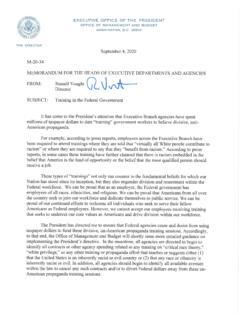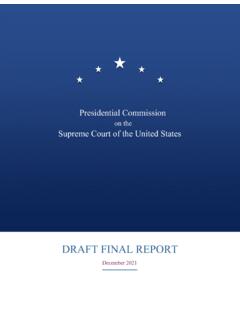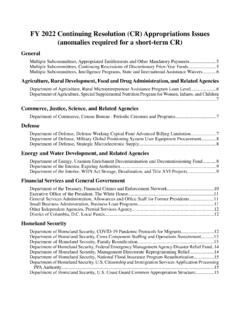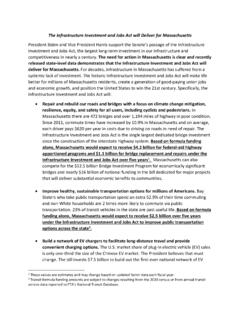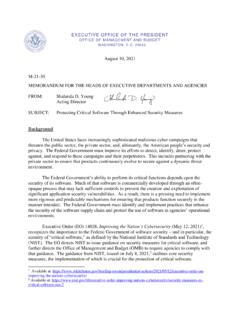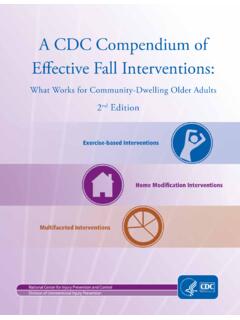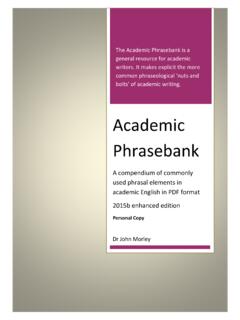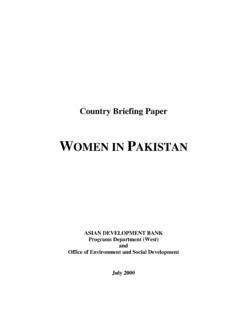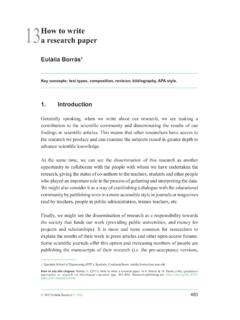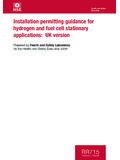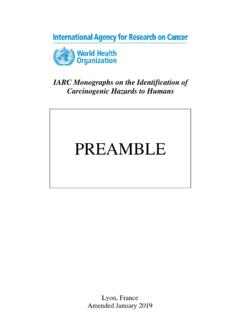Transcription of A ROADMAP TO BUILD A CLIMATE-RESILIENT ECONOMY
1 Climate-Related Financial Risk Executive Order 14030 A ROADMAP TO BUILD A CLIMATE-RESILIENT ECONOMY OCTOBER 14, 2021 Table of Contents Foreword ..4 Introduction ..6 Climate Risk Accountability Framework ..9 Mobilizing public and private finance to support the transition to a net-zero ECONOMY .. 10 Protecting Vulnerable and Disadvantaged Communities .. 12 Protecting Against Financial Risk to the Federal Government and the Communities it Serves .. 13 Safeguarding the Financial System .. 17 Demonstrating Global 19 A Whole-of-Government Implementation Strategy to Address Climate-Related Financial Risk ..21 Financial 21 Protecting American Life Savings and Pensions .. 24 Federal 26 Federal Budgeting, Financial Management and Reporting.
2 27 Federal Lending and Underwriting .. 28 Resilient infrastructure and communities .. 30 Conclusion ..36 Appendix ..37 Executive Order on Climate-Related Financial Risk .. 37 A R O A D M A P TO B U I L D A C L I M A T E-R E S I L I E N T E C O N O M Y 3 Climate-Related Financial Risk: A ROADMAP for Safeguarding the ECONOMY Climate change poses serious and systemic risks to the ECONOMY and financial system. As outlined in this report, the United States government is using all of its tools to properly account for and mitigate climate change-related financial and economic risks, as climate impacts are already affecting American jobs, homes, families hard-earned savings, and businesses. The country must work with urgency to reduce the risks of climate change by addressing its drivers and creating a stronger, more resilient ECONOMY .
3 This report lays out a ROADMAP for measuring, disclosing, managing, and mitigating climate-related financial risk across the ECONOMY , including to the Federal Government, while also catalyzing public and private investment to seize the opportunity of a net-zero, clean energy future. The intensifying impacts of climate change present physical risk to assets, publicly traded securities, private investments, and failure of financial institutions to appropriately and adequately account for and measure these physical and transition risks threatens the competitiveness of companies and markets, the life savings and pensions of workers and families, and the ability of financial institutions to serve communities. In this effort, the Federal Government should lead by example by appropriately prioritizing Federal investments and conducting prudent fiscal management.
4 President Joseph R. Biden Jr. Executive Order 14030, Climate-Related Financial Risk May 20, 2021 A R O A D M A P TO B U I L D A C L I M A T E-R E S I L I E N T E C O N O M Y 4 Foreword The scientific evidence on climate change has grown increasingly stark. Continued warming will further destabilize our climate and produce more frequent and intense storms, wildfires, and heatwaves as well as more damaging droughts and more extensive ecosystem losses. In August 2021, the United Nations Intergovernmental Panel on Climate Change released its latest report in which 234 of the world s leading scientists, citing over 14,000 different studies, concluded with high confidence that the climate crisis is a code red for humanity.
5 This year alone, extreme weather has upended the ECONOMY and affected one in three Americans. Wildfires have burned nearly six million acres of land equivalent to the total land mass of Massachusetts and Rhode Island combined and destabilized international supply chains. After carving its destructive path through the Gulf of Mexico and stalling commodity exports to the world, Hurricane Ida took down the New York City subway system for hours, dumping a record inches of rain in a single hour and bringing commerce in the most populous city in the United States to a On the other side of the country, the Hoover Dam s Lake Mead reached its lowest level since the dam was built in 1931, causing the government to declare the first-ever water shortage on the Colorado River and prompting water cutbacks for regional farmers and the economies they support.
6 As this year draws to a close, the total damage of extreme weather will BUILD upon the $99 billion already incurred by American taxpayers in 2020. Yet, even as the magnitude and urgency of the climate crisis accelerates, the tools we use to assess risks to the ECONOMY to families, to businesses, and to government have failed to keep pace. Wall Street financial models and investment portfolios that manage the assets of millions of Americans continue to rely on the basic assumption that the climate will be stable. Climate risk reporting and disclosure frameworks, although improving, remain inconsistent and only partially adopted by most companies. In addition, the Federal Government s assessments of fiscal and macroeconomic risks have yet to incorporate the physical and transition risks of climate change.
7 In short, the current suite of data, tools, disclosures, and mitigation strategies fail to help investors, policymakers, and the public understand and make decisions grounded in the economic realities of the climate crisis. As a result, America s families, workers, and businesses large and small are vulnerable. The Government, as a whole, is vulnerable. Hard-earned life savings are invested in businesses that are unprepared for the low-carbon transition and thus riskier than current disclosure reveals. Disadvantaged communities in flood- and fire-prone areas are disproportionately exposed to flooding caused by climate change, putting homes and generational wealth at risk. Farmers face increasingly volatile crop yields, making it more challenging to sustain their businesses and feed America s families.
8 In failing to disclose these risks, the Federal Government s balance sheet falls short of providing a credible assessment of the nation s fiscal position. Across the board, hidden and underestimated risks from climate change obscure the growing potential for business disruptions, productivity loss, and bankruptcies. 1 A R O A D M A P TO B U I L D A C L I M A T E-R E S I L I E N T E C O N O M Y 5 By sustaining the status quo, we not only face the mounting repercussions of climate change, but also bear the opportunity cost of missing out on an historic chance for job creation, shared prosperity, and a more resilient future. The United States must integrate climate risks throughout all relevant aspects of the ECONOMY and financial system.
9 And, in doing so, it must meet the moral and economic imperative to rectify decades of disproportionate environmental damage imposed on historically disadvantaged neighborhoods. This report lays out a strategy to advance a whole-of-government effort that safeguards workers and families from financial loss and positions the United States for success in the fight against climate change. It includes a ROADMAP for a long-term effort to BUILD climate resilience throughout the ECONOMY and drive better long-term investment outcomes for ordinary Americans. Specifically, this report pushes forward on a broader economic strategy that invests in the country s physical and human infrastructure, reimagines public procurement policy as a tool to strategically shape markets and spread innovation, embeds resilience within supply chains critical to the clean energy transition, leverages the full talent and creativity of all Americans by elevating equity as a top priority in all policy decision-making, and restores the United States relationship with key allies internationally, finding common ground to meet the global goals of the Paris Agreement.
10 Protecting the financial health of American households, decarbonizing the United States, and building an ECONOMY from the bottom-up and the middle-out all go hand-in-hand. This has been a point of emphasis for the President since his very first day in office, and it will remain an important unifying theme in the days ahead. Gina McCarthy White House National Climate Advisor Brian Deese Director, White House National Economic Council A R O A D M A P TO B U I L D A C L I M A T E-R E S I L I E N T E C O N O M Y 6 Introduction This is a decisive decade that will be defined by the world s collective ability to mitigate and adapt to the catastrophic impacts of global climate change. Over the past century and a half, growing accumulations of greenhouse gases have increased the planet s global average surface temperature by an estimated In its most recent report, the Intergovernmental Panel on Climate Change (IPCC) estimated that the planet will continue to warm until at least the middle of the The changing global climate poses profound risks to the ECONOMY and financial system.


